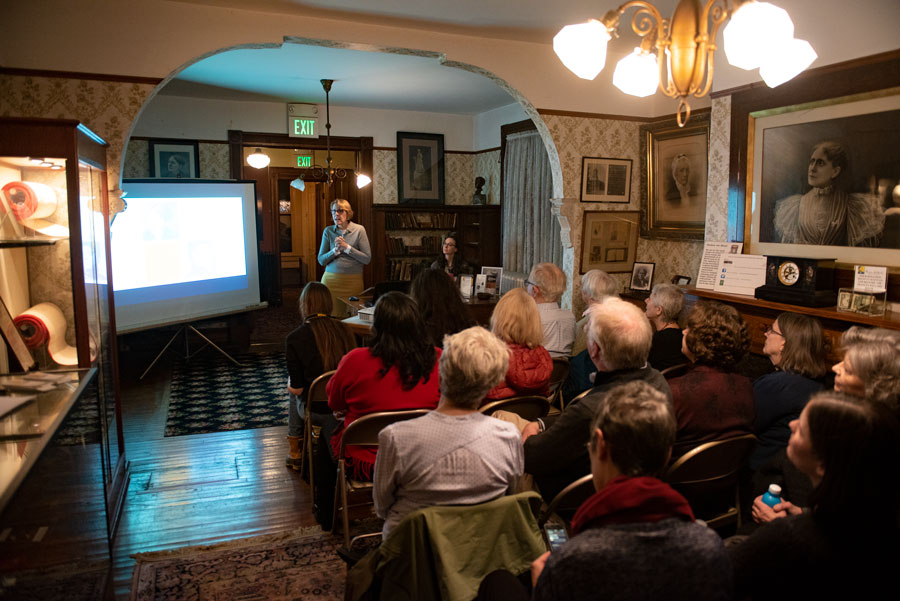Frances Willard House Museum discusses relationship between Willard and Ida B. Wells
Evan Robinson-Johnson/Daily Senior Staffer
Lori Osborne, the Frances Willard House Museum director, speaks to a crowded room Thursday. She introduced the digital exhibit “Truth Telling: Frances Willard and Ida B. Wells,” which reflects on the conflict between the two historical figures.
November 22, 2019
The question of how to not just “display” but “dismantle” the United States’ racist past was key to a new digital exhibit about Frances Willard and Ida B. Wells. Lori Osborne, the director of the Frances Willard House Museum, said during a discussion on Thursday.
In a crowded room in the museum, Ella Wagner, the digital curator of the exhibit, spoke about the history between Willard, who was president of the Woman’s Christian Temperance Union, and Wells, a journalist and anti-lynching activist, in the late 19th century. Osborne introduced the project and its goals.
“We believe that the significant work that the (Woman’s Christian Temperance Union) did under (Willard’s) leadership and beyond to grow women as leaders is still critical to telling the full story of our nation’s history,” Osborne said. “But we also believe the telling of her failures as a leader is important as well.”
In 1890, Willard made racist remarks about African Americans to a newspaper. Four years later, Wells republished the newspaper interview to draw attention to Willard’s statements and pressure her to speak out against lynching.
“Willard could not see that her failure to directly express support for the anti-lynching movement and her use of demeaning and incendiary words to describe African Americans was morally wrong, potentially harmful, and even life-threatening,” Osborne said. “Ida B. Wells would not let Willard remain in a lofty position of power and influence while acting and speaking in such a way.”
To emphasize this history, the museum launched the exhibit “Truth Telling: Frances Willard and Ida B. Wells” in a new website in March. The project began more than two years ago, when Wagner and a group of other Loyola University Chicago graduate students partnered with the museum to research the topic and create a prototype. Wagner was then hired to further curate the history.
Now, the website features a timeline, essential context and interpretative essays.Wagner said a major part of the resource was incorporating primary documents in an engaging way.
“Some of the (primary documents) are quite long and fairly dense, but we did decide to feature them really heavily because so much of this played out in through the written word, through interviews and speeches that were reported on, and letters to the editor,” Wagner said. “A lot of it was through that medium.”
Wagner showed the audience these features and how to use the website to explore more about the history.
Though Evanston resident Barbara Ellson said she had known about the conflict between Wells and Willard, she hadn’t seen the digital exhibit. After the event, she said she was going to use the website to learn more about the history.
“It’ll be interesting to read more about it and what people were saying at the time,” Ellson said.
The event ended with audience members asking Wagner questions about the project. Evanston resident Joaquin Stephenson asked about her personal experience with collecting this history.
“I’m a white woman,” Wagner said. “I can’t say that wasn’t part of my interest in this project: to sort of get a better understanding of how white women who think of themselves as liberals and reformers have managed to nonetheless perpetuate racism.”
Vickie Burke, chair of the Museum Council, also said that examining this history involved grappling with hard issues. She added that everyone involved felt a personal impact while working on the project.
Stephenson said he appreciated the work put into the project.
“It’s incredible research that has been put into action, for the community to be able to access and to tell the story of Willard and Ida B. Wells,” he said. “I know that for myself, I never knew of the conflict, so I think it’s exploring history in a way that’s also accessible online for users of the 20th century.”
Email: [email protected]


